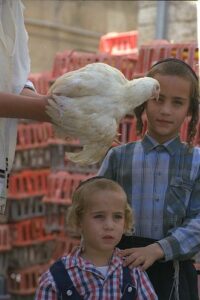47 Then the chief priests and the Pharisees called a meeting of the Sanhedrin.
“What are we accomplishing?” they asked. “Here is this man performing many signs. 48 If we let him go on like this, everyone will believe in him, and then the Romans will come and take away both our temple and our nation.”
49 Then one of them, named Caiaphas, who was high priest that year, spoke up, “You know nothing at all! 50 You do not realize that it is better for you that one man die for the people than that the whole nation perish.”
51 He did not say this on his own, but as high priest that year he prophesied that Jesus would die for the Jewish nation, 52 and not only for that nation but also for the scattered children of God, to bring them together and make them one.
The above passage follows on the heels of the death and raising of Lazarus. Lazarus (or Eleazar) was a well-known Jewish martyr (2 Maccabees 6:18-31). By placing the episode of Lazarus’s death and recovery at this point in the narrative the author was signaling a non-literal meaning. Lazarus is a personification of the Jewish people, one who had been bound and whom Jesus now ordered to be untied; one who had died but was not restored to life. That one man should stand for the entire nation was hardly a novel idea. It is found in Numbers 14:15 (kill this people as one man) and by gematria (a technique that we have seen can be argued to go back to that time) people and man are equivalent in the number 110.
The clearest indicator that Jesus’ death is a substitution is the Barabbas episode. The earliest manuscripts show that Barabbas from the outset was apparently named Jesus. Jesus, son of the father, substituted for another Jesus, son of the Father. (Compare the earlier discussion where NC addressed the derivation of this exchange from the Day of Atonement ritual.) Nothing about this scene was ever thought historical. There was no such custom of prisoner exchange.

NC here discusses the scholarly viewpoints on the meaning of “for” in the sentence “Jesus died for our sins”, with the differences between the Septuagint origin of the idea (Isaiah 53’s suffering servant) and the Hebrew text — the differences between expressing the redemptive reason for the death on the one hand and the beneficiary of the death on the other. This is followed by scholarly views that have been posited on the origin and significance of the Barabbas exchange. NC here also returns to a discussion of the Kapparah ritual (introduced and illustrated in Gospels Cut from Jewish Scriptures #7) that was practiced by Ashkenazi Jews on the eve of the Day of Atonement — Yom Kippur (cf Kapparah). NC quotes an interesting explanation of this ritual that is available in French at Barabbas vs Barrabas and where we read (thank the browser translator) that the event hangs on a wordplay: the sacrificed rooster in Talmudic Hebrew means man in Biblical Hebrew. Guyon drives home a direct comparison with the Pilate scene in the gospels:
After the slaughter, the priest pours a few drops of the blood of each animal on the forehead of each child. The mother keeps most of the sacrificed animals but also gives some for the poor of the synagogue. The priest, for each beast, therefore asks what to do with it …
Let us return to the Gospels and notice three fundamental points of the episode:
– Pilate proposes an exchange to the gathered crowd: a MAN for a MAN, one being sacrificed to atone for the sins of the other
– Pilate asks the crowd: What will I do with Jesus, who is called the Messiah? !
– The crowd answers him by shouting: let his blood fall on us …
How not to see in this episode a picture of that atonement . . . Jesus sacrificed as the animal of Kappara, “offering his life as an expiatory sacrifice” ( Isaiah 53,10) so that men may have Life.
The idea of substitution has a long history. The Talmud tells the story of a confusion between two rivals, one named Kamza and the other named Bar Kamza, that led to the war with Rome and the destruction of the Temple in 70 CE. See Gittin 56b-57a. The Gospel of Barnabas tells us of confusion between Judas and Jesus so that Judas, who was said to be very like Jesus, was crucified. Better known is the substitution of Simon of Cyrene (NC suggests he has been shaped from the Samson character, one who has the strength of God) for Jesus on the cross according to the second century “gnostic” Basilides. A Coptic manuscript from late antiquity describes a meal shared by Pilate and Jesus with Pilate offering to sacrifice his own son in place of Jesus.
The point here is that the idea of substitution lies at the heart of the making of midrash and the shaping of the narrative and figure of Jesus. The idea extends to what we read in the earliest extra-canonical Christian writings where it the “true Israel”, the church, is ordained to replace the “old Israel”, the Jewish people.
The whole narrative and the diverse personifications that we have seen all subtly ride on the themes of substitution and inversion. And it is in that context that the next section, the crucifixion itself, is explored.
–oo0oo–
Continuing…..
Charbonnel, Nanine. Jésus-Christ, Sublime Figure de Papier. Paris: Berg International, 2017.

